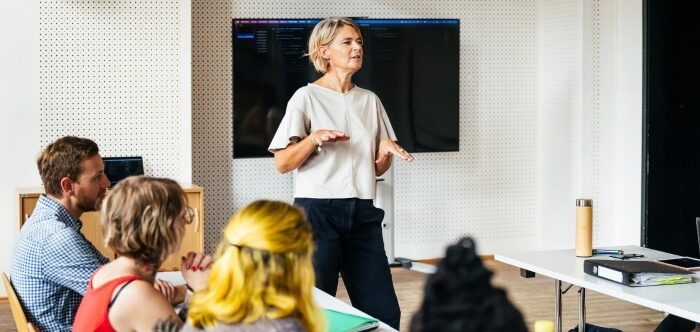Conferences bring people together from different backgrounds, and the way you address them often sets the tone for the entire event. From the opening greeting to acknowledging VIPs and inviting questions, your words shape how professional and welcoming the session feels. So, how do you address people in a conference?
You should address people in a conference by using respectful titles like Dr., Prof., or Mr./Ms., pronouncing names correctly, and choosing inclusive language when speaking to groups. If you’re unsure, politely confirm their preference. This approach shows professionalism and ensures everyone feels valued.
In the following guide, you’ll find scripts, templates, and practical tips for addressing VIPs, introducing speakers, moderating Q&As, and engaging both in-person and online audiences with confidence.
How Do You Address People in a Conference?
The best way to address people at a conference is to use respectful titles, correct pronunciation, and inclusive language. The way you speak influences professionalism and audience comfort. Whether greeting, introducing, or moderating, clear and courteous communication ensures everyone feels valued and engaged throughout the event.

Why Roles Change the Way You Speak?
Not everyone at a conference has the same role. A host sets the tone, a speaker educates, a moderator guides, an attendee asks, and a sponsor thanks. How you address each group makes a big difference in building respect, trust, and connection. These same principles apply when considering how to address people in a meeting or conference. Let’s explore how different roles at a conference shape the way you address people:
Master of Ceremonies / Host
Purpose: As the master of ceremonies, you are the guide of the event. Your job is to set the mood, keep timing under control, and make smooth transitions between sessions. In many ways, this role is about addressing a gathering in a way that feels both organized and welcoming.
Patterns to follow:
- Opening: Warm greeting + brief purpose.
- Transition: Signal the next agenda item clearly.
- Handoff: Introduce the next person by name and title.
- Close: Thank everyone and point to what’s next (break, lunch, wrap-up).
Template (copy-ready):
“Good morning, ladies and gentlemen. I’m [Your Name], and I’ll be guiding today’s sessions. We’re honored to welcome [VIPs]. Our focus today is [theme]. To begin, please join me in welcoming [First Speaker’s Name], who will be sharing insights on [topic]. Thank you.”
Do/Don’t list:
- Do keep it concise, upbeat, and respectful.
- Do double-check name pronunciations.
- Don’t add long personal stories unless planned.
- Don’t forget to signal what’s coming next.
Speaker / Presenter
Purpose: As a presenter, your role is to share knowledge while holding attention. How you greet and invite questions shapes how engaged people feel.
Flow:
- Greet → short value line → address audience directly → invite interaction.
Template:
“Good afternoon, everyone. I’m [Your Name], here to talk about [topic]. Conferences like this give us the chance to exchange ideas, and I hope you’ll find today’s session practical. During my talk, I’ll cover [point 1], [point 2], and [point 3]. Feel free to note your questions, and we’ll have time at the end to discuss them.”
Transition lines:
- “Building on that point, let’s explore…”
- “Now, shifting our focus to…”
- “With that foundation, here’s the next step…”
Panel Moderator
Purpose: Moderators are facilitators. You’re not the star, but you make sure the stars shine — keeping order, timing, and flow.
Patterns:
- Introduce panelists in the right order (by seniority or program).
- Frame each question clearly.
- Manage time and redirect politely.
- Close with a summary and thanks.
Template:
“Welcome to this panel on [topic]. Joining us are [Panelist A], [Panelist B], and [Panelist C]. I’ll begin with [Panelist A] for their view on [question]. After each response, we’ll allow for a short follow-up before moving on. To start, [Panelist A], could you share your perspective?”
Attendee / Delegate (floor mic)
Purpose: As an attendee, you contribute value through your questions. Clarity matters, and when meeting attendees keep their input short and precise, it helps the discussion move smoothly for everyone in the room.
Micro-script:
“Hello, I’m [Your Name] from [Organization]. Thank you for the insights. My question is: [your question].”
Tip: Keep your question under 20 seconds to show respect for time.
Exhibitor / Sponsor
Purpose: When given a mic, sponsors need to thank, add value, and invite — without turning it into a sales pitch.
Micro-script:
“Thank you for having us today. I’m [Your Name] from [Company]. We’re excited to support this event and the conversations it brings. If you’d like to explore [product/service] further, please stop by our booth during the break. We’d love to meet you.”
The way you speak shapes the experience for your audience, no matter the event size or setting. The same approach works in a local business seminar, an academic research forum, an industry expo, or even at a global conference in Canada, USA, or any other country in the world, where diverse voices and expectations meet.
How to Acknowledge VIPs at a Conference?
Acknowledging VIPs is one of the most important parts of a professional conference address, and it is more than courtesy; it signals professionalism, respect, and awareness of hierarchy. Done right, it sets the tone of the event and makes guests feel valued. Skipping or fumbling this step can leave a lasting negative impression, so it’s worth preparing in advance.
When to Do It
You don’t need to acknowledge every name at every moment, but there are three key times where it matters most:
- Opening Remarks: Right at the start of the event, when setting the tone.
- Before Introducing Speakers: To give dignitaries their due recognition.
- Closing Remarks: To thank them again, especially if new guests joined later.
Typical Orders by Event Type
Because every setting has its own culture, the order of acknowledgment differs. Think of it as a hierarchy — you start from the most senior role and then work downward.
Corporate Events
- Senior executives of the host company
- Guest executives from partner or sponsor companies
- Department heads or team leaders
- All attendees and staff collectively
Academic Events
- Chancellor, Vice-Chancellor, or Dean of the institution
- Keynote speakers or distinguished professors
- Faculty members and researchers
- Students and participants
Government or NGO Events
- Ministers, ambassadors, or government officials (highest rank first)
- Heads of NGOs or partner organizations
- Donors, sponsors, or strategic partners
- Delegates and general participants
VIP Acknowledgment Template
Formal Version
“Good morning, distinguished guests, esteemed colleagues, and honored participants. On behalf of [Organization], it is my privilege to welcome [Title + Full Name], [Title + Full Name], and [Title + Full Name]. Your presence lends significance to this gathering, and we deeply appreciate your support. To all attendees, we extend our gratitude for joining us today.”
Neutral / Standard Version
“Good morning, everyone. On behalf of [Organization], I’d like to extend a warm welcome to our distinguished guests. We are honored by the presence of [Title + Name], [Title + Name], and [Title + Name]. We also welcome all participants, whose contributions make this event truly valuable.”
Casual Version
“Hello everyone, and welcome! We’re so glad you could join us today. A special shout-out to [Title + First Name], [Title + First Name], and [Title + First Name] for being here. And of course, thanks to all of you in the audience — you’re the reason this event matters.”
Formality Ladder: Phrases You Can Use (Table)
When you’re on stage, the right phrase at the right moment can make all the difference. Some situations call for a polished tone, especially if you’re thinking about how to address a gathering formally, while others work better with a simple, clear line. Here are 10 common scenarios with ready-to-use examples.
Quick Phrase Table
| Scenario | Formal Phrase | Neutral / Clear Phrase |
| Opening | “Good morning, distinguished guests. It is my honor to welcome you all to [Event].” | “Good morning, everyone. Thanks for being here at [Event].” |
| Late Start | “We apologize for the slight delay and appreciate your patience as we begin.” | “Thanks for waiting, we’re ready to get started now.” |
| Move to Keynote | “It is now my privilege to introduce our keynote speaker, [Name].” | “Let’s welcome [Name], our keynote speaker today.” |
| Invite Q&A | “At this point, I would be pleased to take your questions.” | “Any questions or thoughts you’d like to share?” |
| Redirect Off-topic | “That is an interesting point; however, let us return to our main subject.” | “Great thought, but let’s bring it back to today’s topic.” |
| Transition to Break | “We will now adjourn for a short intermission. Please return at [time].” | “Let’s take a break. We’ll meet back here at [time].” |
| Return from Break | “We hope you had a refreshing break. Let us reconvene with our next session.” | “Welcome back! Let’s dive into the next session.” |
| Thank Sponsors | “We extend our deepest gratitude to our sponsors for their generous support.” | “Big thanks to our sponsors for making this event possible.” |
| Close | “We are most grateful for your presence and engagement today. Thank you all.” | “Thanks for joining us. We really appreciate your time.” |
| Final Farewell | “We bid you farewell and look forward to your continued engagement.” | “Thanks again, everyone. Safe travels and see you next time.” |
This ladder covers the most frequent situations you’ll face in a conference setting. Use the formal versions when you want a professional polish, and the neutral ones when you just need to keep it clear and friendly.
How to Address the Q&A Audience to Keep it Clear and Concise?
Running a Q&A session can feel tricky if you don’t set the rules early. Without some structure, people may talk too long, drift off-topic, or feel nervous about speaking up. That’s why having clear lines prepared makes things smoother. When you’re addressing an audience in a conference, these little phrases can save you from awkward pauses or confusion. Let’s look at some simple scripts you can use.
Ground Rules You Can Say Out Loud
Before questions begin, set the tone with a quick reminder:
- Time: “We’ll keep questions short so more people can participate.”
- Brevity: “Please keep your question to about 20 seconds.”
- Names: “Start by sharing your name so we all know who’s speaking.”
Ready-to-Use One-Liners
- Invite first question:
“Let’s open it up, who would like to start us off with the first question?” - Clarify a long question:
“That’s a great point. To make sure I understand, are you asking [restate question briefly]?” - Group similar questions:
“I’ve noticed a few questions touch on the same theme. Let me combine them into one.” - Handle no questions:
“If there aren’t any questions right now, I’ll share one I often get, and we’ll go from there.” - Park an off-topic question:
“That’s interesting, though not today’s focus. Let’s connect during the break to talk more.” - Close Q&A gracefully:
“We’re at the end of our time. Thank you for the thoughtful questions; they really added to today’s discussion.”
These short lines keep your Q&A moving without feeling forced. Use them as building blocks, adjust them to your style, and you’ll always sound prepared while keeping the audience engaged.
How to Handle Common Conference Hiccups Smoothly?
Even the best-planned conferences face a few hiccups, from technical glitches to time overruns. What matters is how smoothly you handle them at the moment. Having a few ready lines prepared can keep the event calm and professional. Let’s go through some simple scripts you can use.
Technical Issue (mic, slides, Wi-Fi)
- “It looks like we’re having a quick technical issue. Please bear with us while we sort this out.”
- “While the slides load, let me explain the key point so we don’t lose time.”
Interruptions or Side-talk
- “I’d like everyone’s attention up here so we can stay on track.”
- “Let’s bring the focus back to the discussion so everyone can follow along.”
Late VIP Arrival
- “We’re pleased to welcome [Title + Name] who has just joined us – thank you for being here.”
- “We’re glad [Title + Name] could make it. Let’s continue with the program.”
Schedule Slip / Overrun
- “To respect everyone’s time, we’ll shorten the next session slightly so we can stay close to schedule.”
- “We’re running a bit over, so let’s move quickly into the next item.”
Heated Exchange
- “Both points are valuable. For now, let’s pause and keep moving with the agenda.”
- “That’s clearly an important issue, let’s note it and revisit it in a separate discussion.”
These quick scripts give you a calm way to handle bumps without losing control of the room. Keep them in mind, adjust to your style, and your audience will remember how steady you were under pressure.
Cultural and Inclusive Language Guide
Every audience comes with different backgrounds, and how you address people shows whether you respect that diversity. From using titles correctly to making sure everyone can follow along, small choices in language and delivery can make a big difference when it comes to engaging conference attendees. Let’s explore some simple ways to keep your words thoughtful and inclusive.
Titles and Honorifics
Use professional titles like Dr., Prof., or Hon. when addressing someone in a formal or academic setting. These titles acknowledge their role and achievement. If you are unsure, check the event program or politely confirm with the person beforehand. Dropping titles without permission may feel dismissive in some cultures.
Pronunciation Prep
Nothing feels worse than hearing your name mispronounced on stage. Prepare ahead by creating a name list with phonetic spellings. If you’re unsure, ask the person privately before the event or even confirm briefly when introducing them:
“Please correct me if I mispronounce your name, as I want to get it right.”
Gender-Neutral and Respectful Address
When speaking to a group, avoid language that assumes gender, such as “ladies and gentlemen,” if the context doesn’t demand it. Instead, try “everyone,” “colleagues,” or “friends.” This makes all attendees feel included without singling anyone out. Even people at a conference appreciate being spoken to in a way that feels open and welcoming.
Accessibility Considerations
Keep in mind that not everyone processes information the same way. A few easy habits can help:
- Pace: Speak clearly and avoid rushing.
- Captions: For virtual or hybrid events, enable captions whenever possible.
- Mic Height: Adjust microphones to suit different speakers.
- Slides: Read key points aloud so people who can’t see the screen don’t miss out.
Pronunciation & Titles Checklist
Here’s a quick printable list you can prepare before stepping on stage:
- Write down VIP names with phonetic spellings.
- Double-check correct titles (Dr., Prof., Hon., etc.).
- Confirm unfamiliar names directly with the person if possible.
- Keep a backup card or note with tricky pronunciations.
- Prepare one inclusive greeting line (e.g., “Good morning, everyone”).
By paying attention to names, titles, tone, and accessibility, you show every attendee that their presence matters. These small steps take little effort but leave a lasting positive impression on your audience.
Virtual and Hybrid Variation
Conferences today often mix in-person and online audiences, which means the way you address people has to fit both. It’s easy for remote participants to feel left out if you only focus on the room. A few simple habits can make the whole group feel included. Let’s go through some useful lines and tips you can use.
Chat Etiquette and Repeating Questions
When attendees join online, many prefer typing in chat instead of speaking. Recognize those contributions and make sure their voices are heard.
- “I see a few thoughtful comments in the chat. Let me share one of them with everyone here.”
- “That’s a good question from the chat. For those in the room, I’ll repeat it so we’re all on the same page.”
Acknowledging Remote VIPs
If important guests are online, a quick mention makes a big difference.
- “We’re honored to have [Name/Title] joining us virtually today.”
- “A warm welcome to our colleagues online, especially [Name], who has joined us from overseas.”
Using Polls, Raised Hands, and Latency Awareness
Online platforms give you tools to keep people engaged. Polls, hand-raise features, and reaction buttons make interaction easy. Just remember to pause a little longer after questions, since remote participants often need a few seconds more.
- “Let’s take a quick online poll; you should see it pop up now.”
- “If you’re on Zoom, please raise your virtual hand and I’ll call on a few of you.”
- “I’ll pause for a moment so our online participants can unmute or type their responses.”
Examples: Virtual-Only Opener & Remote Handoff
Virtual-Only Opener
“Welcome to everyone, whether you’re here in person or joining us online. It’s great to see such a mix of participants. If you’re remote, feel free to drop your name and location in the chat; we’d love to know where you’re tuning in from.”
Remote Handoff
“Before we continue, I’d like to bring in [Name], who is joining us virtually. [Name], the floor is yours.”
Including both in-person and online audiences takes just a few thoughtful phrases. By recognizing remote voices, repeating their questions, and giving them space to engage, you make sure no one feels left out of the conversation.
Common Mistakes to Avoid (Scannable List)
Even skilled speakers can slip up if they’re not careful, and small missteps can affect how the audience sees you. Knowing what to avoid helps you come across as confident, respectful, and organized. Here are the most common mistakes worth watching out for.
Over-acknowledging
It’s good to thank people, but reading a long list of names one by one can drag on. Mention the most important names first, then acknowledge the rest as a group to keep things moving.
Reading Verbatim
If you read every word from your notes, you’ll sound flat and disconnected. Use your notes as a guide, but speak naturally. Audiences respond better when they feel you’re talking to them, not reading at them.
Using Jargon or Acronyms
Not everyone in the room will know insider terms. If you must use an acronym, explain it briefly the first time. Simple, clear language keeps everyone included and avoids confusion.
Skipping Names or Titles
Getting names wrong or leaving out titles like Dr. or Prof. can feel disrespectful. Double-check the spelling and pronunciation beforehand. A little effort here shows you value the people in the room.
No Plan for Q&A or Time Overruns
When Q&A sessions run too long, or the schedule slips, audiences lose focus. Always have a clear plan: set time limits, prepare polite closing lines, and know how to move the event forward without rushing or stalling.
Avoiding these common mistakes is just as important as knowing what to say. With a bit of preparation and awareness, you’ll keep your delivery smooth and leave your audience with a strong impression.
FAQs
Even after learning the main techniques for addressing people at a conference, small doubts still come up. These questions often pop into speakers’ minds right before or during an event. To help, here are answers to some of the most common concerns.
How Can I Calm My Nerves Before Speaking at a Conference?
Feeling nervous is very normal, even for experienced speakers. Taking a few deep breaths and rehearsing your opening lines can help. Remind yourself that the audience is there to listen, not judge.
What Should I Do If The Audience Looks Distracted?
If you notice attention slipping, adjust your tone or ask a quick question to bring people back. Movement, like stepping closer to the audience, also works well. Keep energy in your delivery.
How Do I Politely Stop Someone From Talking Too Long During Q&A?
Thank the person for their point, then gently redirect. You might say, “That’s a helpful thought, let’s hear from another voice as well.” This keeps the session balanced and fair.
Is It Okay to Use Humor in a Formal Conference?
Yes, but use it sparingly and carefully. Stick to light, relatable humor that fits the event’s tone. Avoid sensitive topics, and always read the room before making a joke.
What If My Microphone Stops Working Mid-Speech?
Stay calm and don’t panic. Speak up clearly so people in front can still hear while technicians fix the issue. If needed, pause briefly and thank the audience for their patience.
How Can I Keep Virtual Participants Engaged During A Session?
Involve them through polls, chat shout-outs, or short pauses for input. Repeat their questions so in-person attendees can hear as well. These small steps show remote voices matter just as much.
Concluding Lines
The way you speak at a conference has the power to shape how people see you and the event itself. A warm greeting, respectful acknowledgment, and clear delivery show both confidence and professionalism.
When asked, how do you address people in a conference, the answer lies in combining courtesy with practical communication. From recognizing VIPs to engaging attendees, each step makes the experience smoother for everyone involved.
Finally, it’s about creating a space where people feel respected and included. With the right words and a thoughtful approach, you’ll leave a positive impression and make your conference role both effective and memorable.









